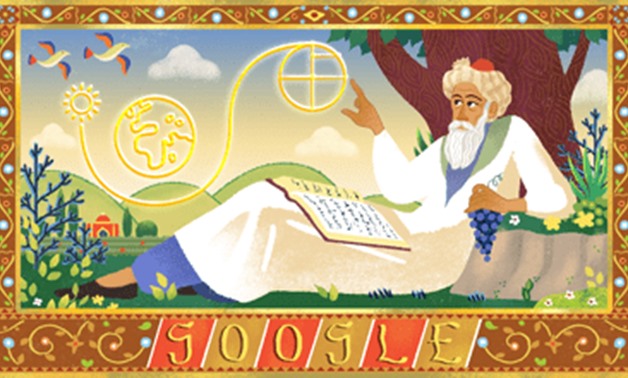
Google doodle honors Omar Khayyam.
CAIRO – 18 May 2019: Omar Khayyam was an outstanding mathematician and astronomer who wrote several books such as Problems of Arithmetic, a book on music, and one on algebra before he was 25 years old.
His full name was Ghiyath al-Din Abu'l-Fath Umar ibn Ibrahim Al-Nisaburi al-Khayyami. He studied philosophy at Naishapur.
Khayyam considered the problem of finding a right triangle having the property that the hypotenuse equals the sum of one leg plus the altitude on the hypotenuse.
This problem made Khayyam to succeed in solving the cubic equation x3 + 200x = 20x2 + 2000 and he found a positive root of this cubic by considering the intersection of a rectangular hyperbola and a circle.
An approximate numerical solution was then found by interpolation in trigonometric tables. Khayyam states that the solution of this cubic needs the use of conic sections and that it cannot be solved by ruler and compass methods, a result which would not be proved for another 750 years.
Khayam transferred to Samarkand in Uzbekistan in 1070, one of the oldest cities of Central Asia. Khayyam was much backed by jurist of Samarkand, and this allowed him to write his most famous algebra work, ‘’Treatise on Demonstration of Problems of Algebra.’’
The book housed a complete classification of cubic equations with geometric solutions found by means of intersecting conic sections.
In fact, Khayyam gives an interesting historical account in which he claims the contributions by earlier writers such as Al-Mahani and Al-Khazin were to translate geometric problems of the Greeks into algebraic equations, something which was essentially impossible before the work of Al-Khwarizmi.
However, Khayyam himself seems to have been the first to conceive a general theory of cubic equations.
Another achievement in the algebra text is Khayyam's realisation that a cubic equation can have more than one solution.
He demonstrated the existence of equations having two solutions, but unfortunately he does not appear to have found that a cubic can have three solutions.
Also in his algebra book, Khayyam refers to another work of his which is now lost. In the lost work, Khayyam discusses the Pascal triangle but he was not the first to do so since al-Karaji discussed the Pascal triangle before this date. In fact we can be fairly sure that Khayyam used a method of finding nth roots based on the binomial expansion, and therefore on the binomial coefficients.
Khayyam is best known as a result of Edward Fitzgerald's popular translation in 1859 of nearly 600 short four line poems the Rubaiyat.
Khayyam's brilliance as a poet has caused some to forget his scientific inventions which were much more important. The best known of his poems is the following:
The Moving Finger writes, and, having writ,
Moves on: nor all thy Piety nor Wit
Shall lure it back to cancel half a Line,
Nor all thy Tears wash out a Word of it.
Comments
Leave a Comment